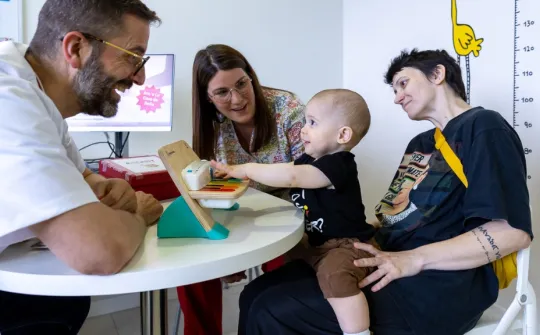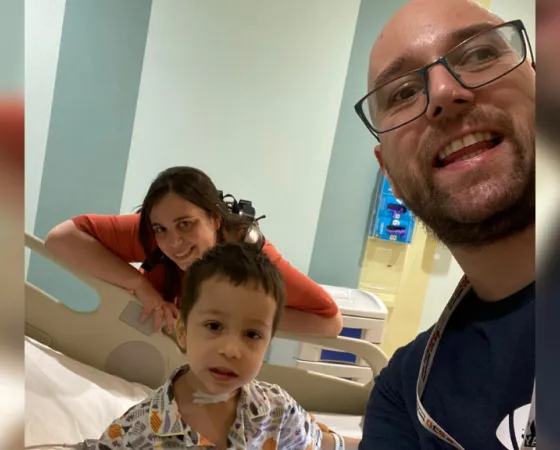We are specialists in the complex treatment of airway obstruction problems by fetal surgery.
Pathology description
What is Congenital High Airway Obstruction Syndrome or CHAOS?
Congenital High Airway Obstruction Syndrome (CHAOS) is a rare congenital anomaly (present before birth) in which the upper airways of the fetus are almost or completely blocked. It affects fewer than 1 in 5000 pregnancies.
Obstruction can occur in different parts along the length of the airway, causing their partial development or absence. Depending on its origin and where it occurs, we refer to them by different terms:
- Laryngeal atresia or stenosis: partial development of the larynx (the tube in the neck just before the trachea, through which we breathe and which contains the vocal cords) with an interruption or blockage of it. This is the most common obstruction leading to CHAOS.
- Tracheal atresia or stenosis: partial development of the trachea (the tube that goes from the larynx to the lungs, through which we breathe) with an interruption or blockage of it.
- Tracheal agenesis: complete absence of the trachea.
- Other non-malformation causes such as the presence of a cyst or membrane that obstructs the trachea or larynx, which are otherwise well formed.
All suspected cases of CHAOS should be carefully evaluated by an experienced multidisciplinary team. Determining the type and status of the blockage will guide the prognosis and treatment strategies. While CHAOS is life-threatening if untreated, advances in treatment and prenatal imaging have improved outcomes.
Why does it occur?
The underlying cause of CHAOS is unknown, but in approximately 50% of cases it is associated with other malformations, chromosomal abnormalities or genetic syndromes (typically Fraser syndrome), which gives a very poor prognosis.
The other half of the cases present as an isolated disease with no other problems, are considered to be sporadic and do not increase the risk of recurrence.
What kind of problem does CHAOS represent?
During life inside the uterus, the fetus does not use the lungs to breathe, but the blood is oxygenated through the placenta. In the case of CHAOS, fluid that is normally produced in the lungs and bronchial tree and that normally enters and exits with the movements that the fetus makes is trapped in the lungs.
This causes the lungs of the fetus to inflate under pressure, which leads them to increase in an exaggerated way in size and, as a result, compress the heart, preventing it from functioning normally. This can lead to severe heart failure, with accumulation of free fluid in different parts of the fetus (hydrops fetalis). If the problem persists, fetal death will usually occur.
CHAOS syndrome

Diagnosis
Diagnosis is made by ultrasound. Signs of CHAOS are usually evident at an early stage, appearing before 20-22 weeks of pregnancy:
- The fetal lungs appear greatly enlarged in size and are bright (echogenic) bilaterally.
- The airways are dilated and prominent, and the dilated, fluid-filled bronchial tree can be identified by ultrasound.
- The diaphragm (respiratory muscle) loses its normal shape and is pushed down into the abdomen.
- The heart is compressed and displaced towards the middle of the chest, surrounded by huge lungs.
- In advanced stages, and in most cases already at the time of diagnosis, there is accumulation of fluid in the fetal abdomen (ascites) and potentially in other fetal compartments (hydrops fetalis).
- The amount of amniotic fluid may be increased (polyhydramnios) due to the large compression on the oesophagus (the tube through which food reaches the stomach) and the added difficulty of swallowing. Polyhydramnios can trigger a premature birth and worsen the baby's prognosis.
Given the rarity of this condition, the above findings can sometimes be confused with a primary lung mass. An accurate diagnosis of CHAOS by an experienced team caring for a large number of fetuses with this syndrome and other fetal lung lesions is essential, as advanced diagnoses combined with experience can lead to better long-term outcomes.
What tests are needed to know the prognosis in my case?
Once the diagnosis has been made, a comprehensive evaluation by an experienced fetal medicine team is essential, which will assess whether it is an isolated case of CHAOS or whether there are other added problems. To this end, a series of studies and different assessments are carried out:
- Ultrasound and echocardiography to calculate the size of the lungs and assess cardiac function.
- Amniocentesis and genetic tests to know whether the case of CHAOS is associated with other genetic abnormalities and rule out that it is an isolated case of CHAOS.
- MRI to help identify the precise site of the obstruction.
- Multidisciplinary assessment involving fetal medicine specialists, neonatologists and pediatric surgeons.
Treatment
In some cases it is possible for CHAOS to resolve spontaneously on its own. This spontaneous resolution is typically associated with non-malformation cases in which there is a membrane or cyst in the trachea.
But precisely these cases with a better prognosis are dramatic if the baby is born at term and cannot breathe. The obstruction of the larynx or trachea is beyond the vocal cords so it cannot be diagnosed or treated with a simple intubation, but urgently requires an endoscopy or surgical tracheostomy (making a hole in the front of the neck and in the trachea). This operation is not viable at most centres where babies are delivered and, if born in one of these centres, the baby may die or be left with severe neurological sequelae due to the lack of oxygen to the brain.
This observation forms the basis for considering fetal surgery in utero in selected cases with isolated CHAOS, with no other added problems, and a normal genetic evaluation, especially if the presence of a laryngotracheal membrane or cyst is suspected. In this case, the procedure is performed by fetoscopy, in the same way as for congenital diaphragmatic hernia (CDH), accessing through the fetus' mouth and advancing until the vocal cords are visualized.
During fetoscopy, a severe atresia or laryngeal malformation may be diagnosed that makes treatment impossible and forces the intervention to be cancelled. However, if the presence of a membrane or cyst is confirmed, or in some cases where it is observed that the trachea is well formed below the malformation of the larynx, the obstruction may be perforated. This puncture allows previously trapped fetal lung fluid to escape at very high pressure, leading to normalization of the size and appearance of the fetal lung, the previously dilated tracheobronchial tree, the position of the diaphragm and the volume of the amniotic fluid, as well as the resolution of hydrops fetalis over time.
This approach to treating CHAOS requires early diagnosis, rigorous evaluation and in-depth counselling by a multidisciplinary team with extensive experience in managing fetal abnormalities before, during and after birth.
What appointments are needed for fetal surgery?
An in-patient admission of the pregnant woman will initially last 1–2 days and afterwards weekly check-ups with examination and ultrasound will be required, and she will have to maintain a low-activity lifestyle mainly at home until the end of pregnancy, especially for the first 3-4 weeks after the intervention. Normally, pregnancy can continue to term without the need to induce it prematurely.
During pregnancy, you will receive the support of nurses specialized in fetal medicine, not only on a technical level but also on an emotional level throughout the process. In addition, we can put you in contact with other families who have gone through the same experience. This is very positive and helps to humanize and understand the problem in a much more intuitive way and without the difficulties that sometimes arise when receiving only technical information from professionals.
Why SJD Barcelona Children's Hospital?
For parents who wish to continue their pregnancy care and have their baby at SJD Barcelona Children's Hospital, we offer a fetal surgery team with the best survival and quality of life figures that can currently be obtained.
We are pioneers in the treatment of CHAOS and bronchial atresia by fetal surgery, having performed some of the first CHAOS surgeries in the world.
Experience and efficiency
We are pioneers in the treatment of CHAOS and bronchial atresia by fetal surgery, having performed some of the first CHAOS surgeries in the world
- We are experts in the surgery that these fetuses require, a complex and delicate treatment that demands very high precision but that in expert hands is not very aggressive for the pregnant woman and the fetus, and can completely change its prognosis, saving its life.
- We have successfully performed fetal surgery for the first time in the world in a bilateral CHAOS with hydrops fetalis caused by a laryngeal membrane and also in a unilateral CHAOS with hydrops fetalis caused by a major bronchus atresia. After fetal surgery, both fetuses developed well, recovered from hydrops fetalis, were born at term and had a correct postnatal evolution, without any need for other treatments.
- We have subsequently dealt with other similar cases, and the intervention has also been carried out successfully by a few groups in the world. It is a complex and delicate treatment, which requires very high precision but in expert hands it is not a very aggressive treatment for the pregnant woman and the fetus, and if successful it will completely change the prognosis, saving the life of the fetus and achieving a normal quality of life in the short or medium term.
We are a multidisciplinary team, which allows us to approach surgery in a comprehensive way.
Personalized patient-centered care
We are a multidisciplinary team, which allows us to approach surgery in a comprehensive way
Before surgery we evaluate each case in detail, performing very high-resolution ultrasound and magnetic resonance tests, and perform analysis in multidisciplinary teams that include experts in each of the fields, including fetal medicine, fetal and pediatric surgery, otoraryngologists, neonatologists, radiologists and any other specialty that may be necessary.
We will discuss the case in detail with the parents and talk about the best options for your baby. Parents will be able to speak in detail not only with specialists in medicine and fetal surgery, but also with pediatricians who are experts in the monitoring and evolution of these children, to get to know in detail the expected evolution in each case and the best options.
We accompany you with an individualized postnatal follow-up.
After the birth we continue with our patients
We accompany you with an individualized postnatal follow-up
To the excellence of the prenatal team is added a third-level paediatric center with teams made up of a large number of specialists with specific training in neonatal intensive care, and that have the best and most modern technology. For the surveillance during the first days after birth, the hospital has every day of the year, at any time of the day, highly qualified medical and nursing professionals in the care of these delicate patients.
Once discharged, our paediatric teams will follow the baby for the first few years and take care of him or her to achieve optimal development and to solve any problems in this very fundamental part of life.
In addition to our substantial surgical experience, being at the same time one of the most important research and development centres at an international level, we constantly incorporate improvements in materials and techniques that allow us to further increase the precision and speed of our interventions.

